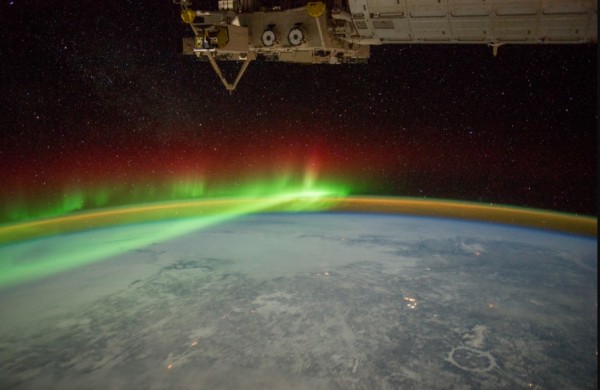By Ana Verayo, | March 06, 2017

An astronaut aboard the International Space Station adjusted the camera for night imaging and captured the green veils and curtains of an aurora over Quebec, Canada. (NASA)
In a new study, scientists have revealed that solar storms can strip away electrons from the Earth's atmosphere. When a solar storm strikes the planet, it first crashes with the planet's magnetic field or magnetosphere. This creates a space where the charged particles scatter within the ionosphere, which is also the outer layer of Earth's atmosphere.
Like Us on Facebook
Solar storms are linked to excessive presence of electrons. However, this new study reveals that electrons suddenly disappear from massive regions in the atmosphere and collect in other areas. "We obtained measurements of a specific solar storm that hit the Arctic Circle in 2014. Our new findings show how electrons in large quantities disappear in areas ranging from 500 to a thousand kilometers. These electrons are vacuum cleaned in an area of heavy increased of electron density that are called patches," Per Høeg from the Technical University of Denmark said.
Scientists from the Technical University of Denmark and NASA's Jet Propulsion Laboratory have identified this phenomenon in the Earth's atmosphere. However, they are still trying to figure out what causes sit. During surveys, the team gathered intensive data obtained from satellites and geomagnetic measuring stations linked to this 2014 solar storm.
The DTU team's mission in to obtain a better understanding of how atmospheric phenomena such as electromagnetic storms can affect communications and navigation systems. With this new evidence, researchers will continue to monitor electromagnetic data to find clues about the missing electrons in Earth's atmosphere.
"The data we have collected in this research can be both used for practical applications and theoretical models. By studying both, we will achieve a basic understanding why this happens," DTU Space's Tibor Durgonics said. "We also identified a number of critical factors that affect the quality of satellite navigation to make better assessments in order to predict when this phenomenon will occur. On a theoretical standpoint, we discovered how solar storms cause electrons to disperse and disappear from the ionosphere which is the exact opposite of something you would expect from a solar storm hitting Earth."
This new study was published in the journal, Radio Science.
-
Use of Coronavirus Pandemic Drones Raises Privacy Concerns: Drones Spread Fear, Local Officials Say

-
Coronavirus Hampers The Delivery Of Lockheed Martin F-35 Stealth Fighters For 2020

-
Instagram Speeds Up Plans to Add Account Memorialization Feature Due to COVID-19 Deaths

-
NASA: Perseverance Plans to Bring 'Mars Rock' to Earth in 2031

-
600 Dead And 3,000 In The Hospital as Iranians Believed Drinking High-Concentrations of Alcohol Can Cure The Coronavirus

-
600 Dead And 3,000 In The Hospital as Iranians Believed Drinking High-Concentrations of Alcohol Can Cure The Coronavirus

-
COVID-19: Doctors, Nurses Use Virtual Reality to Learn New Skills in Treating Coronavirus Patients







